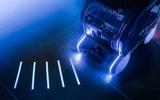Jaguar Land Rover has developed a system that projects the direction of travel onto the road ahead of a self-driving vehicle.
The system has been designed to tell other road users what the vehicle is going to do next and is intended to alleviate concerns over a lack of trust in autonomous vehicles.
The projections, tested on autonomous pods, use a series of lines with adjustable spacing. The gaps lessen as the vehicle is preparing to brake and extend when the pod accelerates. When approaching a turn, the bars spread to the left or right to indicate the direction of travel.
The research programme is part of the broader UK Autodrive autonomous and connected driving project, which involves numerous self-driving trials from not only Jaguar Land Rover, but also Ford and Tata.
Last year, as part of the same research, Jaguar Land Rover revealed an autonomous pod with ‘virtual eyes’, which can signal to pedestrians when it is safe for them to cross a road.
The projection tech was tested on a fabricated street scene in Coventry, with engineers recording trust levels reported by pedestrians with and without projections.
Jaguar Land Rover said the projections could be used to share obstacle detection and journey updates with pedestrians in the future.
Pete Bennett, future mobility research manager at Jaguar Land Rover, said: “The trials are about understanding how much information a self-driving vehicle should share with a pedestrian to gain their trust. Just like any new technology, humans have to learn to trust it, and when it comes to autonomous vehicles, pedestrians must have confidence they can cross the road safely.
“This pioneering research is forming the basis of ongoing development into how self-driving cars will interact with people in the future.”
Read more
JLR tech to held drivers avoid red lights
Tesla Model S vs Jaguar I-Pace: twin test









Join the debate
Add your comment
What they really need....
....with their reliability reputation is not a self-driving vehicle, it’s a self-repairing vehicle.
Why waste resources on this
Surely better to concentrate all your efforts into improving the quality and reliability of your existing range. Is Michael Edwardes back?
Alll this technological
Alll this technological wizardy is nice.. but surely every penny should be more urgently going into working out why a BMW X1 puts out 50g/km less than an E-Pace or Evoque, today's problems!